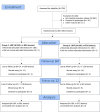Effectiveness of nanosilver fluoride and silver diamine fluoride in arresting early childhood caries: a randomized controlled clinical trial
- PMID: 38890627
- PMCID: PMC11184862
- DOI: 10.1186/s12903-024-04406-3
Effectiveness of nanosilver fluoride and silver diamine fluoride in arresting early childhood caries: a randomized controlled clinical trial
Abstract
Background: One of the most prevalent health problems affecting children worldwide is untreated caries in primary teeth. Agents to arrest caries are used to manage untreated decay in children in disadvantaged communities. Nano Silver Fluoride (NSF) overcomes the staining problems of Silver Diamine Fluoride (SDF). This study compared the clinical cariostatic effect of NSF to 38% SDF for arresting caries lesions.
Methods: The study included 360 children younger than 4 years, with at least one active lesion, ICDAS score ≥ 3, recruited from nurseries in a rural area in Alexandria, Egypt, in 2022. They were randomly assigned to receive a single application of NSF at baseline, or two applications of SDF at baseline and after 6 months. The arrest of active carious lesions was assessed after 6 and 12 months using ICDAS criteria, and parents' satisfaction with child appearance was also assessed. Chi-Square test was used to compare the groups and multi-level multiple logistic regression was used to assess the effect of the intervention on caries arrest at lesion level and binary logistic regression was used to assess the effect at patient level.
Results: 1853 active lesions were included in children whose mean (SD) age was 42.3 (8.2) months. The arrest rate was significantly higher in the NSF than the SDF group at lesion level (78.4% and 65.0% at 6 months and 71.3% and 56.3% at 12 months, p < 0.001). In regression analysis, NSF had significantly higher odds of caries arrest than SDF at lesion level (at 6 months, AOR = 2.57, 95% CI: 1.55, 4.26 and at 12 month, AOR = 3.27, 95% CI: 1.89, 5.67). Parents of children receiving NSF had significantly greater satisfaction with their children's dental appearance than those receiving SDF: (97.2% and 76.1%, respectively, p < 0.001).
Conclusion: NSF demonstrated greater effectiveness in arresting caries in preschool children without inducing black staining of teeth and with greater parental satisfaction than SDF. NSF can be an alternative to SDF in arresting caries especially in underprivileged communities.
Trial registration: The trial was registered in the clinicaltrials.gov registry (#NCT05255913)-16/02/2022.
Keywords: Caries arrest; Children; Early childhood caries; Nano silver fluoride; Primary teeth; Silver diamine fluoride.
© 2024. The Author(s).
Conflict of interest statement
MET is a Senior Board Member at BMC Oral Health. The other authors declare no conflict of interest.
Figures
References
-
- Policy on Early Childhood Caries (ECC) Classifications, consequences, and preventive strategies. Pediatr Dent. 2017;39(6):59–61. - PubMed
-
- Kassebaum NJ, Smith AG, Bernabé E, Fleming TD, Reynolds AE, Vos T, Murray C, Marcenes W, Collaborators GOH. Global, regional, and national prevalence, incidence, and disability-adjusted life years for oral conditions for 195 countries, 1990–2015: a systematic analysis for the global burden of diseases, injuries, and risk factors. J Dent Res. 2017;96(4):380–7. doi: 10.1177/0022034517693566. - DOI - PMC - PubMed
-
- !!!. INVALID CITATION !!! [3].
-
- El Tantawi M, Folayan MO, Mehaina M, Vukovic A, Castillo JL, Gaffar BO, Arheiam A, Al-Batayneh OB, Kemoli AM, Schroth RJ, et al. Prevalence and Data Availability of Early Childhood Caries in 193 United Nations Countries, 2007–2017. Am J Public Health. 2018;108(8):1066–72. doi: 10.2105/AJPH.2018.304466. - DOI - PMC - PubMed
Publication types
MeSH terms
Substances
Associated data
LinkOut - more resources
Full Text Sources
Medical





